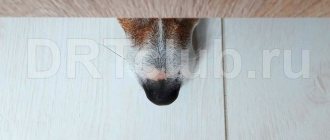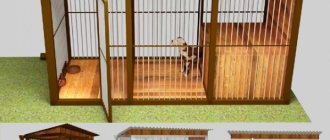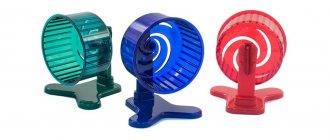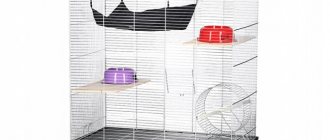Greetings to all do-it-yourselfers, as well as dog breeders!
Today I want to share an idea for making a very simple, homemade choke leash for training young dogs and puppies.
I think every dog owner knows that any dog (both large and small) must have certain training skills and obedience to the owner. Moreover, this does not mean at all that every dog needs to be intensively trained and undergo a GCD (general training course).
If the dog is not a service dog, but is kept in the family simply as a pet and friend, then the ability to walk on a leash and knowledge of at least two basic commands: “stay” and “come to me” is enough for it. This alone makes the dog manageable and obedient, and on occasion it can simply save its life, especially in the dangerous conditions of a big city.
At the same time, it is advisable to begin raising a dog from puppyhood. Well, in order to facilitate and speed up the upbringing and training of a dog, it is very good to use a special device in the form of a leash with a strict collar or a choke collar.
It must be said that there are now a huge number of different strict collars on sale. Moreover, the basis of all these collars is the property of tightening like a noose or noose with a sharp jerk, which naturally has a certain effect on the dog.
However, such collars are often quite expensive. But at the same time, there is no particular point in buying them, since such a collar is needed only for the period of raising and training the dog.
For example, I have long been convinced that in ordinary cases, for the successful training of a dog, a very easy-to-make, homemade noose leash is quite suitable. Such a leash can be easily made in a few minutes, and it will cost almost nothing. At the same time, it can last for a very long time and with its help, you can raise more than one generation of dogs.
I've been using a similar leash for many years now. This is what he looks like.
As you can see, it can be made from ordinary rope.
Purpose of the noose leash
All dogs are different, each has its own special character. There are large dogs that behave very excitedly during walks, chasing every cat, dog or even bird. In this case, it is usually incredibly difficult for the owner to keep a large dog on a leash. It is for such dogs that a noose leash is needed, with the help of which the dog can be stopped without much difficulty. Moreover, this dog training collar fits very well.
ATTENTION! After using the choke for some time, the dog usually gets used to normal behavior and then the choke can be replaced with a regular collar.
Toy and treat
How to catch a dog? With her favorite toy or treat.
First of all, the animal is called. Not just once, but constantly called by name. Not this way: “Jessie” and look after the rapidly running away pet. And we act like this: “Jesse-Jesse-Jesse-Jesse.” The dog reacted, we immediately show him his favorite toy. We wave to her, attracting the attention of our pet.
99% of dogs react to their toys. They want to play, they want to get it. And they lose interest in the stimulus they were chasing.
The same goes for treats. The dog is shown a treat if the distance allows this.
The method is suitable for those domestic dogs that chased a cat, for example. And they did not have time to escape far enough from the owner.
If the dog is scared and rushes into the distance, not making out the road, there is no time for toys and treats. You will have to run after her, appealing to the animal’s mind by calling by name.
Features of leash training for an adult dog
The stages of training an adult animal differ from those described earlier. If a dog has spent a long time in an enclosure or a kennel cage, its training begins with a leash about 8 meters long. Work with the dog in an open area, the leash should hang freely. The leash is shortened gradually as you get used to it. Usually an adult animal does not want to walk on a short leash. Treats are used for training. When luring the dog with a tasty morsel, they make sure that it does not run ahead and block the owner’s path.
One lesson with an adult dog should not exceed half an hour in duration.
Leash training an adult dog requires patience from the owner.
Nooses, half-nooses, ringovki
Noose
represents a sliding loop that tightens when pulled or pulled. Typically made of metal links, nylon or leather.
The principle of influence is based on causing the animal a state of discomfort and eliminating it when the leash is loose. The noose is not intended for everyday wear on walks for several reasons:
- when free-range, it falls off when the head is tilted, so it is easy to lose;
- the dog may get caught on a branch or other protruding part of the surrounding landscape and receive serious injuries;
- when playing with other dogs, if your paw gets caught in a loop, there is a risk of injury to another animal;
- An excitable or untrained pet, constantly pulling on the leash or making sharp jerks on the noose, quickly gets used to causing discomfort and stops responding to it.
The ease of use is that the noose can be easily and quickly removed over the head when necessary.
A half-choke collar (martingale) differs from a choke collar by the presence of a stopper, which allows the loop to be tightened only to a certain limit.
Martingale refers more to ammunition for everyday use, rather than for correctional education.
It, like the noose, can be quickly removed and put on over the head. Suitable for long-haired breeds to avoid matting. Suitable for excitable, fearful or aggressive dogs, as it prevents them from turning away and running away.
When free, the noose and martingale should not hang from the neck by more than 4-8 cm. When playing with dogs, such types of equipment must be removed to avoid injury or death.
A show ring (in common parlance, a “leader”) is a collar, or a single combination with a leash, intended for displaying an animal at an exhibition. It is, as a rule, a rather narrow, smooth round cord with a retaining ring and a hand loop
It must be durable and not conspicuous, so as not to distract attention from the competitor and allow the exterior to be appreciated. According to the design principle, although the ringovka is similar to a noose, it should not be a means of correction.
Training a puppy using a choke collar
For some puppies, using a choke collar is a must. Still untrained puppies are distracted with the help of a noose from various external factors that interfere with training. If the noose is used wisely, it does not cause any harm to the dog, but it helps the owner cope with the still uncontrollable dog. When the dog jerks, the amount of incoming air decreases and this immediately moderates the ardor of a temperamental dog.
The noose itself looks like a regular collar, but it does not have a standard clasp. Instead there are restrictive rings. When putting the collar on the dog, it is passed through one ring and the loop is placed around the pet's neck. A leash is attached to the other ring. When it is not pulled, the collar is completely loose around the neck. As soon as the dog jerks, the leash tightens and the choke tightens, causing the dog to experience discomfort.
REFERENCE! There is also a noose collar with a lock or with three rings on sale. Their action is the same, only the third ring limits the size to which the collar can be tightened. Even with this diameter it will no longer tighten and certainly will not choke the dog.
Use for behavior correction and training
A dog training noose is an indispensable accessory for the owner. Because with its help you can achieve obedience in a short time. If used correctly, the collar will not harm the dog.
It is necessary to accustom oneself to such a collar from puppyhood, since an adult dog has already formed its character, and the dog can react to the noose aggressively or passively. In case of aggression, the dog is calmed down, distracted from the leash by loosening the tension. After the pet has completely calmed down, you can gradually begin studying. Over time, the pet will form a reflex, and it will stop pulling in different directions.
With a passive reaction, the dog lies down and does not pay attention to the owner’s commands. In this case, dog handlers recommend making a slight jerk and rewarding him at the slightest activity. After some time, the animal will understand that the noose will not harm it and will unquestioningly carry out its tasks.
Important! A collar can cause serious stress.
A noose is a reliable assistant during training
Training a dog with a choke collar
This collar is intended for training purposes only. It is better to carry it out in a deserted place so that no one distracts the animal.
Actions during classes:
- The pet is placed at the left leg.
- Next, the owner begins to move slowly. In this case, the dog should walk alongside, and the leash should be loosened and slightly sagging.
- If the dog makes a jerk to the side, you need to stop. When stopping, the noose tightens, creating discomfort for her.
- After the dog returns to its original place, the movement continues. The owner must make it clear to him that he must walk clearly with his left foot. If the dog does everything correctly, he needs to be praised.
Experts recommend using a noose only during exercise, and putting your pet on an ordinary collar while walking. This is explained by:
- during play, it may slip off the neck;
- when running, it can get caught on something and cause injury to the animal;
- With constant use of a noose, the dog’s conditioned reflex disappears and it stops responding to the discomfort caused.
During games, the noose is removed
Usage
The choke collar is used for training dogs from 5 months. It is unacceptable to use on puppies and is not recommended for use on small breed dogs, as there is a high risk of injury to the cervical spine and suffocation.
The accessory is placed around the neck and a leash is attached to the end through which the noose does not slip. The collar should not put pressure on the neck, so it should be worn so that two fingers folded together can be inserted between it and the neck. A collar that is too tight will cause breathing problems. If everything is done correctly, then when tensioned, the loop will tighten, and after reducing the tension, the loop will loosen.
Choke collars are not intended for everyday use; they are worn only during training and training. Many dog owners purposefully buy nooses for daily walks, considering them convenient, because they hang freely and do not spoil the hair, and do not cause inconvenience to the dog if it does not pull the leash. Such use is unacceptable, because there are other types of collars for such purposes.
During the training process, you should not pull the noose. You need to show the dog that it is not he who gives the direction. The trainer, holding the leash closer to the base, walks at a normal pace, abruptly changing direction, thereby tightening the leash, the dog experiences unpleasant sensations, the trainer loosens the leash and rewards the animal with a treat, stroking or words. You should not leave an animal in a choke collar unattended. As you watch the video, notice that the trainer does not jerk the leash sharply.
Sew a collar
The easiest way to consider this process is step by step:
Taking into account the parameters of the dog, you need to make a cut of material (fabric). It should be equal to the width of the intended product, multiplied by 3. If the collar is 4 cm wide, the cutting width should be 12 cm. The length should also be taken with a margin, depending on the type of clasp chosen. To secure the flexiblex you need at least 2 extra cm at each end. For a mechanism with a buckle, you need to leave 2 cm to secure the plaque and a small tail with 1-2 additional holes.
The resulting cut must be folded in three widths and ironed. You will end up with one edge folded, and the other raw edge lying on top. If the fabric is not fleecy, you can leave the edge in its original form; if threads stick out from it, it is better to burn them. The folded piece of fabric must be basted along each edge, and then sewn with a stitch. After this, all that remains is to put on the flexiblex or buckle. If you need to make holes, you need to make them with a hot awl, otherwise they will quickly fray. You can decorate the product at your discretion.
Note!
- DIY medical mask: TOP-140 photos of the best DIY options. Instructions for making a mask at home
How to make a piggy bank with your own hands - the best ways to make a piggy bank with your own hands. Detailed master class for beginners with photos and videos
- Cold porcelain: features and methods of making it at home. Reviews of the best recipes + 120 photos
It is convenient when the leash clings not to the collar, but to a special ring. You can find it on old bags, use a link from a chain, or buy it at a hardware store. At the same time, it is important to secure it so that the ring does not travel along the entire length of the collar. To do this, you need to put the ring on the collar, right in the middle. In this place, on the reverse side (which is adjacent to the animal’s body), make a patch for this ring, thus securing it completely.
Material of manufacture
There is a large selection of choke collars with three or two rings for dogs on sale. The material from which they are made can be leather or its substitute, metal chains, links or nylon cord. When choosing a choke for each dog, you need to study all the pros and cons of the material from which it is made.
Let's look at the collar options:
- Nylon noose It is considered the most durable collar, as it glides well without clinging to the ring. You can wear such a collar in any weather and you can even swim with it in the sea or other body of water.
The downside of a nylon collar is the possibility of causing pain to the dog and also cutting the owner’s hands.
- Leather collars for dogs are considered the most beautiful and pleasant for the owner. Leather harnesses are suitable for dogs with short hair and are very comfortable for them. The disadvantage of a leather collar is that it requires special care, or it will quickly lose its attractiveness. 3. Metal can stain dog hair where they come into contact. In addition, wool can get into the joints of the metal chain links. For these reasons, metal chokes are not used on dogs with long, light hair. They are used mainly for smooth-haired dogs. These collars look very beautiful and are used mainly during exhibitions to decorate pets.
NOTE! There are also combination collars made from nylon cord to increase durability, with the addition of nice leather.
Distinctive features of a half-garrote
The half-choke collar has another name, it comes from France - martingale . Initially, it was a belt in the harness, designed to prevent the horse from throwing its head back too high.
As dog ammunition, a martingale is the same noose, the rings of which have a chain threaded through them (most often, but sometimes a strap) to which a leash is attached. The principle of operation of both the choke collar and the half-choke collar is the same: the reins are pulled, the collar is tightened; the materials from which they are made are the same.
However, this type has certain advantages, for example, with a martingale, a dog cannot be strangled or injured like a noose, since there are two rings that determine the minimum length of the collar.
The main thing is when choosing a half-choke, choose this minimum length correctly, so you need to measure the narrowest place in girth on the neck (behind the ears). If the collar is chosen correctly, the dog will not be able to get out of it against the will of the owner.
Also, you can familiarize yourself with other types of collars: “Anti-bark”, a collar with GPS.
What is a dog show ring?
To obtain the coveted victory at the exhibition, the correct choice of show ring plays an important role. And also important is the handler’s ability to control this accessory.
A ring leash on a dog. Such leashes are present in the list of products of almost every manufacturer of pet products; there are a very large number of them on sale.
Materials and design
Rings are made from different materials. The most popular are leather or nylon leashes . You need to fasten the leash behind the pet's ears, or open it wide and lie on the animal's back, on the chest, passing through the shoulder blades.
At their core, rings are a device in between a collar, a noose and a leash. They are manufactured in a wide variety of designs. There is also a fashion for the advantages of their appearance, color scheme and material. But the right to choose it always remains with the pet owner, regardless of fashion trends.
The ringovka is made from different materials.
Gallery of show rings
A show leash is a show leash.
You need to know how to use it.
There are a large number of varieties.
The leash is attached to the ears.
The ring is not noticeable on the dog.
You should select according to the color of the dog's coat.
The danger of stray dogs
Why do you need a choke collar for dogs?
Through dogs that are not examined by veterinary institutions and that are not vaccinated, many dangerous diseases are transmitted to people and their pets, and the environment is polluted. Livestock suffer from their invasion, and cases of attacks on children and adults have become more frequent. They often cause road accidents.
Note! Most often, cyclists, joggers, and wheelchair users are attacked. In order to reduce the number of stray animals, conversations are held with the local population about the inadmissibility of negligent treatment of animals, uncontrolled walking on the streets, laws are approved that stipulate the conditions for keeping animals, fines are introduced for mistreating animals, throwing them into the street
In order to reduce the number of stray animals, conversations are held with the local population about the unacceptability of negligent treatment of animals and uncontrolled walking on the streets, laws are approved that stipulate the conditions for keeping animals, and fines are introduced for mistreating animals and throwing them onto the street.
Ways to fight
But the most effective way to combat it remains to catch stray dogs and then place them in animal shelters. Old, sick and unclaimed animals for a long time must be euthanized. Animal protection organizations oppose this inhumane method, proposing to catch mongrels for the purpose of sterilizing them, thereby regulating the dog population.
Crowd of stray dogs
But during the mating period, catching dogs is still inevitable. Most often, homeless animals accumulate in gardens, fenced areas, abandoned construction sites, and landfills.
Note! Only by reducing the number of stray dogs to 20% can we expect to stop the growth of stray dogs. Measures aimed at controlling the number of stray dogs will help reduce the costs of their maintenance and sterilization
These costs include:
Measures aimed at controlling the number of stray dogs will help reduce the costs of their maintenance and sterilization. These costs include:
- maintaining special government services and equipment for catching mongrels;
- payment of sick leave related to dog bites;
- damage from road accidents caused by four-legged animals.
Leash-noose at home
You can make a pretty decent dog collar with your own hands. To do this, you need approximately 4 meters of nylon cord, 3 metal rings, glue, strong synthetic thread and heat shrink tubing.
In order to make a collar, you need to thread a nylon cord through the ring and make a pigtail of the required length, leaving a reserve. You can calculate the required length of the noose by measuring the circumference of the dog's neck and subtracting the diameter of the ring from there. When braiding a braid, you need to weave a ring that will act as a retainer. At the end of the braid, it needs to be threaded into the second ring and bent. Then the bent ends need to be scorched over the flame, connecting them behind the ring.
To make the collar more durable, the joint must be tied with thread and glued with universal glue. The ring that acts as a limiter also needs to be secured with thread and glue. If it doesn’t turn out very neatly and beautifully, you can cover the joint with heat-shrink tubing. Well, the noose is ready for your dog.
Wicker options
You can weave a dog collar from a number of available materials. For this you can use:
- Fabric scraps;
- Old belts;
- Clothesline or nylon rope.
In addition to the above, you will need to take care of the clasp. This can be a flexiblex or a noose-type mechanism or a semi-noose type mechanism. For a noose, 2 identical metal rings are required, for a semi noose, 3 rings and a chain.
Note!
Cake decorating: TOP-170 photos of the best ideas for decorating a cake at home + instructions for beginners with simple patterns
- How to make a house out of cardboard: 140 best photos of children's crafts with your own hands + step-by-step manufacturing instructions with simple diagrams
DIY rose lamp - step-by-step instructions for creating a lamp with your own hands + original design ideas with photo reviews
Do-it-yourself martingale collar
If the noose is too much for you, then we suggest making a half noose.
You will need:
- Raincoat
- Izolon or polyethylene foam
- Metal rings (can be D-shaped)
- Sling
- Optional, ribbon (for finishing)
We calculate the length of the collar - this is the circumference of the neck, minus the diameter of the ring. Add five to seven millimeters to the width of the sling and get the width of the collar.
We cut out a rectangle of the required size from the isolon, lay it on the raincoat fabric, add two centimeters to all sides, and cut it out again.
We cover the isolon with raincoat fabric.
We measure the sling 30 centimeters longer than the neck in circumference in order to firmly secure the rings.
Actually, we attach the sling to the collar blank, thread it through the rings and firmly sew the ends with a triple stitch on the machine.
Important! From one end we release the required length of the sling, pass this end through the second ring, then attach it to the side of the collar from which it comes. This is our control circuit.
The second ring can be secured in the middle of the control outline by stitching it with a cross stitch.
We remove the threads that were used to sweep away the sling with the workpiece and our martingale is ready.
Before using such collars, be sure to consult with a competent dog handler . He will give you detailed instructions and recommendations.
Taking measurements from your pet
To determine the length of the sling, taking into account all the necessary fastenings, first of all, we need to measure the circumference of the pet’s neck. If you don't have a soft sewing meter at hand, you can use any ribbon and then measure it with a regular ruler. Or just use the old collar as a guide.
You have measured the circumference of your dog's neck. We multiply the resulting value by 1.7.
That is, if your dog has a neck girth of 30 cm, multiply this figure by 1.7. It turns out that you will need a sling 51cm long. This will be the length of the main large outline.
For a small control circuit, the line should be slightly shorter. This length does not depend on what size your furry friend is. A sling length of 30-35cm will be sufficient.
The small contour only allows you to freely put the collar over your head, and then evenly distribute the load when the dog tightens and loosens the leash.
You don't have to worry that the collar will be too small or too big. To adjust the desired girth, we will later make an additional buckle on the main contour.
But you need to decide in advance on the width of the sling. The choice of sling width directly depends on the size, breed and age of your furry friend. If you have a large breed dog, then the sling should be wider and the fittings stronger.
For my Jack, I took fittings and a 2.5 cm wide sling. By the way, the size of all accessories is selected based on the width of the sling, and is measured by the width of the holes into which the sling will be threaded.
Possible errors and problems
When training, mistakes are possible, the admission of which complicates training or makes it incorrect.
- Jerk before the command is given. He knocks the dog down and doesn’t make it clear what they want from him.
- Driving a dog on a tight leash. Execution of the “nearby” command must be carried out on a loose leash, and subsequently without it, otherwise the dog will get used to the constant feeling of tension on the collar and will begin to consider this the norm.
- Giving a command with different intonation. The dog will not be able to remember all your intonations and associate them with a specific command, and a rude tone may even frighten him.
- Repeating the command when the dog walks nearby. If the dog follows a command, it should not be repeated again. This way, the pet can associate repeated issuance of a command with the norm and will carry it out only on a double command.
- The position of the dog when walking side by side is half a length forward/backward. This position of the dog makes it difficult for him to give other commands with a gesture, and also slows down the pet’s reaction to changing traffic conditions.
- Parallel study of different commands. It is difficult for an animal to learn several commands at once; it is worth practicing them one by one.
- Punishment for failure to follow commands. When teaching a dog commands, it is strictly not recommended to raise your voice or physically punish it. In this case, your pet’s training will be associated with negative emotions and will become ineffective.
Photo: Scott 97006
Photo: Virginia State Parks
Raising a dog is a labor-intensive process that requires patience and time, but the result can not only ensure its safety and save you stress, but also make your pet a well-deserved source of pride.
How to use it correctly?
On the address book you must write down all the information that will allow you to return your lost pet home. Usually all inscriptions are applied on both sides.
- On one side they indicate the name of the dog, and along with it the phone number of the owners. The address is rarely included because it may end up in the hands of people associated with crime. Not every person agrees to risk their safety like that.
- On the back of the token or tag, you can indicate special additional information, for example, that the pet is a guide dog or suffers from some kind of illness or needs treatment. Sometimes owners use a trick and specifically indicate on the address book that their pet is seriously ill with something, so that no one wants to keep the dog without returning it to the breeder. However, such information can also play a bad joke on the four-legged dog - people may be afraid to contact him because of his illness.
Often the address cards contain information that allows other people to immediately understand that the pet is lost. In such cases, the owners prefer to write:
- “Call the owner!”;
- “Bring me home!”;
- "I want to go home!";
- “I’m lost (or lost)!”
To apply an inscription, you can turn to engraving. For this purpose, special automatic equipment is used. It acts on the part with a special diamond tip, which removes the top layer from the token, leaving very thin and neat grooves.
Much here depends on the material from which the selected address card is made. Typically, engraving is used when the product is made of metal. The softer this material is, the deeper and more noticeable the furrow will end up.
There is also a laser engraving method. In accordance with it, the top layer is also removed. Here you can apply larger and wider symbols. This method of applying text to a token is considered optimal because it gives good results and does not take up a lot of free time.
The prepared address card with all the information printed on it must be correctly and firmly attached to the collar of your four-legged friend. For fastening, it is recommended to use high-quality and tight rings with a cross-section of at least 1 mm or special carbines designed for such elements. The latter are very convenient at moments when you need to remove the address card in order to wash the collar or change it to another one.
If the sound of the token irritates you, you can use a remedy such as anti-ringing. It is made from soft silicone rubber. It fits tightly to the surface of the token, as if hugging it. As a result, the sounds that the addressee makes are inevitably absorbed, and the person stops hearing them. Anti-ringers can glow in the dark.
How to teach a dog to walk next to you without a leash
You should start learning to walk side by side without a leash only when the dog has learned to confidently walk side by side on a leash, without straining it and maintaining the required position.
To practice walking side by side without a leash, make the leash longer and give a command when the pet walks on a loose leash.
Gradually increase the distance; when the distance exceeds 5 meters, call the dog with the command “come to me”, and only then give the command “near”. And don’t forget to reward with praise, affection or treats.
Photo: Scoutdogs (Chris)
When your pet masters the “near” command from a distance of 5 meters, you can begin practicing the command at a distance when the dog walks without a leash.
However, remember that mastering walking side by side without a leash does not mean that you can eliminate walking on a leash - the dog may gradually become spoiled and stop maintaining the distance and the necessary position in space.
Advantages and disadvantages of a leash
Dog owners who have chosen a leash-controller highlight the following advantages of the product:
- Unlike a strict collar, it does not cause any harm to the pet. You just need to pull the leash slightly, and the dog will understand what is required of it and will walk next to the owner.
- Allows you to gently and painlessly correct the unwanted behavior of your four-legged friend.
- Used as both a collar and a muzzle.
- It is equipped with a reliable metal fastener, which allows you to hold the collar on the neck – the most sensitive part of the dog’s body. Thanks to this, there is no need to constantly correct it. He will not slide off the dog.
- Another clip can be attached to a waist belt or bicycle handlebar. Thus, the owner’s hands will always be free, or he will be able to walk two or more dogs at the same time.
- The device has optimal weight, it is comfortable to use and hold in your hands.
- Suitable for dogs of all sizes and breeds.
- Can be used for pets starting from the age of 3-4 months.
The leash controller is rightfully considered one of the most effective means of training pets. The noose does not cause any harm to the dog and does not injure it during the training process. Professional dog handlers appreciated this device. They consider it a good help in training a dog. However, before training your pet, you need to figure out how to put such a leash around the animal’s neck.
Training with the product
conclusions
It is worth remembering that the beauty of this accessory is certainly important, but its purpose is to restrain the dog. Therefore, pay more attention to the strength of materials and the quality of stitching. After all, an animal with a sudden movement can damage them and escape from your hands. If you doubt that the ring you made yourself will not be able to withstand the impulse of your pet, then purchase a leash in the store.
Show rings for dogs must be made of durable material.
Application of nodes
For these purposes, a variety of knots and loops are used. There is a simple fastening and a very complex one. In life, situations sometimes occur when knots of different levels of complexity are used.
While fishing on a boat, the exact opposite unexpected situations may overtake you. Here are some examples.
Very loosely tied braid or monofilament to the spool can cause the spool to accidentally fall into the water. She will drown if you try to get her out of the water using the tip of the braid. If the cast is not at a great distance, then it may be possible to find it in the water from the shore, but from a boat such an operation is problematic.
The opposite example. If the line is also very loosely tied, and you make a cast, for example, a force majeure event may occur when, out of nowhere, some reckless driver on a boat runs over it. What will happen? If the attachment point were tight, the spinning rod would simply fly out of your hands and drown. A weak fastening in this case saved the reel and spinning rod, but the fishing line could not be returned.
Do you remember any life situations when the same loop can harm and save?
Fastening
Each fisherman has his own preferences in the field of tying loops and, as a rule, does not use different techniques, but once he gets his hand on one, he uses it all his life. Today, reels are sold equipped with a clip or stopper to which the braid is secured. Using this development, you can avoid tying the fishing line.
Some recreational fishermen do not use loops or modern monofilament mounts at all, but simply wind a large amount that holds it on the spool. When winding 200 meters, using only 100, the monofilament will become motionless.
The disadvantages of this tactic lie in the fact that while fishing you will periodically have to get rid of some part of the frayed fishing line. Eventually there will come a point where tying a knot is inevitable because the amount of monofilament will not be enough to hold it.
Winding line onto the reel spool
Beginner fishermen wonder about the amount of fishing line wound on the spool. In this case, professional fishermen advise to reel until there is 1 or 2 mm left to the side. Why so many? This will provide a large casting range. Under no circumstances should you wind the line to the level of the spool side, as the rings and beard will begin to fall off. Tips for correct and economical fishing line winding:
- If you purchased a small reel in a store, you can wind the whole thing with fishing line, it will completely fit into the reel seat.
- If the reel is capacious, then you don’t have to waste fishing line on it. True, if the monofilament is inexpensive, otherwise this winding will cost you a large sum.
- You can save money with a capacious coil as follows. If you choose expensive fluorocarbon or braid, first wrap a piece of adhesive tape or tape before moving on to the expensive material.
- You can also do this. If you don’t want to pay a lot for expensive material and a capacious reel, then you can also use cheap monofilament instead of adhesive tape, which is tied to the braid and wound onto the reel first. This cheap piece, which is used for winding, is called backing. Its calculation is easy.
Rules for tying loops
There are a large number of knots, but it is necessary not only to know how to tie one or another, but to bring the process of tying it to perfection and do it “automatically”. To achieve this, you need to constantly train. Tips for tying loops:
- Do this, for example, always while watching television.
- Avoid using teeth when tightening knots; use pliers.
- The main requirement when tying fishing line to the spool is that the knots should not stretch.
- Place the loop on the bottom of the spool, as this is where it will come into least contact with the line.
- You can use your usual knowledge and tie the fishing line in your usual way.
To avoid unpleasant situations, all hinges should be made in compliance with safety requirements.
- All rules for tying a knot must be followed.
- Knots must be resistant to untying and tearing.
- Units should be selected taking into account the purpose of application.
- Regardless of the condition, the ropes should be easy and effortless to untie.
How to teach a dog to walk next to you without a leash
You can accustom your dog to the “Near” command without a leash no earlier than at the age of 6 months, and the pet must move well “near” on a leash.
Take a longer leash and first act in the same way as in the first stage
- give the command when the dog is walking on a completely loose leash. However, gradually increase the distance from which the command is given (if the dog is further than 5 meters from you, then first you need to give the command “Come to me”, and only then “Near”).
When the dog has learned to carry out a command from a distance of 4-5 meters, try to command when it is walking without a leash
. Remember: in order for your pet to perfectly follow commands without a leash, he must regularly walk “side by side” on a leash. If you are lazy and force your dog to walk “side by side” only without a leash, then in a week it will stop obeying.
Reliability, functionality and safety
The primary question in the process of making ammunition for an animal is: how to sew a collar for a dog with your own hands so that it is not only beautiful, but also durable
In this case, it is important to focus on such parameters as the size, speed, character of the pet and, importantly, preferred walking areas
So, for small dogs that are not prone to running away, a decorative collar-ornament is suitable; for pets who pull, it should be tight, well fixed with a reliable clasp. For medium-sized and giants, it is desirable to have good quality ammunition that will not let you down in any situation.
It should be taken into account that if the dog often goes to the beach and loves to swim, a leather collar will not suit him (it stretches and deteriorates from frequent exposure to water), and a metal clasp is not advisable, since after a couple of swims it will become rusty or oxidized. When the dog often walks on sand or clay soil, the accessory on the neck will be constantly smeared, grains of sand will get clogged into the porous fabric.
Firstly, such details can damage your four-legged friend, and secondly, a playmate can accidentally swallow part of the decor and get health problems.
Training conditions
You should start training a dog only if it is in normal physical condition (not sick, not depressed and does not refuse food). It is better to feed the dog a couple of hours before, and take it for a walk just before practicing the commands, so that it does all the necessary things and slightly wastes energy, which will prevent absent-minded attention.
You should choose a secluded area for training - at the beginning of training, you do not want unnecessary noise and the presence of strangers, which the dog can be distracted by. It is better if it is a fairly spacious area in the fresh air that is familiar to the dog, with an even surface.
At first, it is better to avoid noisy places. Photo: Kate Hart
When the dog begins to make progress in mastering the command, you should slightly add distractions - change the training location or invite spectators. However, if the dog is very distracted, it is too early to leave the secluded training area.
What you need for training
To teach the “near” command, you will need a collar, a leash, treats for reward, and your favorite toy will also come in handy.
Training should be done daily for 15 minutes. If the dog is tired or distracted, it is best to stop training and continue the next day.
Which delicacy to choose
Treats for reward during training should be in the form of small pieces, not crumble and not get your hands dirty. You can only choose the most suitable treat for your dog through experience. These can be pieces of chicken, sausages, vegetables, fruits, cheese, dry food, and store-bought treats.
Industrially made treats for dogs
Some dogs willingly work for pieces of biscuits. The treat needs to be chosen so that it is desirable for your dog. It is better to choose several types of treats and alternate them periodically so that the dog does not get bored with them.
When to use a special collar
It is not always possible to teach a dog commands using ordinary techniques and equipment. If the dog is a fairly large breed, disobedient, hyperactive or aggressive, then a special collar can help you: a choke collar, a strict collar or an electronic collar.
All this ammunition requires knowledge of its practical use and special care in use.
When does a dog need a protective collar?
The animal instinctively tries to lick a fresh wound or scratch an itchy spot with its paw. Veterinarians strongly recommend wearing a post-operative collar for dogs to prevent them from accidentally harming themselves.
A protective device will be needed in the following cases:
The postoperative period requires time for the sutures to heal. Do not allow your pet to lick or scratch the wound to relieve pain and itching. The fastening threads may not hold up and come apart. And penetration of infection into the wound will lead to serious complications. Ophthalmic diseases are accompanied by itching and lacrimation. Medicinal ointments are applied to the eyes for a long time. The animal will try to scratch the itchy area with its paws and wash off the medicine
This is especially true for cataract surgery and other complex eye procedures, when it is very important to protect from mechanical damage. Ear diseases also cause itching and require the use of a veterinary collar. Injured limbs are put in plaster or splinted. The dog usually does not accept the foreign object and tries to remove it
Such actions can lead to disruption of the process of bone fusion and healing of periosteal tissues. Skin problems require aseptic conditions and the application of ointments: dermatitis, allergies, bacterial and fungal diseases. Animal intervention can spread the infectious agent to healthy areas of the body or aggravate the disease by scratching itchy areas. When treating wool against parasites, toxic drugs are used. Licking the fur after the procedure can lead to poisoning. The puppy bitch is protected if she thoroughly licks her nipples, causing milk production. Males are recommended to wear a collar after castration.
Does training success depend on the dog's breed?
As a rule, all dogs are trainable, regardless of breed and size; differences can only be in the speed of mastering the command. Some breeds (retrievers, poodles, German shepherds, papillons, shelties, Dobermans and Rottweilers) learn faster, some (chow-chows, bulldogs, Afghan hounds) take longer, but it all depends on the owner, his readiness and efforts in training the pet.
Also, the speed of learning can be affected by the characteristics of the pet - dogs with high activity are less able to keep their attention on the task at hand.
How to tie a scaffold knot
This article will list all possible self-tightening loops that can be used for bondage and selfbondage. Running simple knot
Knitted in 3 movements, it is one of the simplest self-tightening knots. When pulling at the end, the loop is tightened; in order to increase the loop, when it is not yet very tight, you need to pull the loop in the opposite direction.
Sliding eight
Knitting this loop is not difficult at all, so you shouldn't have any problems with it. In general, such a knot is usually used when tying bags or the like, but we can use it, for example, to tie legs or arms.
Sliding blind loop
It is also knitted in 3 stages, first we fold the rope in half, then, as shown in the picture, we pass the ends into a loop and then tighten it. You can use this knot as a noose for rope handcuffs.
Running bowline
Knot of medium complexity. It is based on the lasso principle. Often used in maritime affairs, for catching logs and anchors.
Silk knot
The snare knot is used by bird catchers. The knot is considered one of the smoothest and easiest knots to tighten.
Scaffold node
The name of this node speaks for itself. It was used in ancient times for hanging, but we can use it for our binding works.
Tightening noose
Like the previous knot, it is called a scaffold or gallows knot. As you already understood, it was used for hanging.
To tie this knot, the cable is laid in the form of two loops of equal size. Both loops are surrounded several times with the running end of the cable, after which this end is passed into the loop facing the root part of the cable and, pulling out the outer loop, is clamped in it. A tightening noose can always be easily untied by pulling the main part of the cable.
Drunk and shackled
Drunk on the left and shackled on the right.
These two knots are almost similar; when you tie them, you get 2 tightening loops or, more simply, self-tightening handcuffs.
1 review to “Tightening loops”
MAGICALLY. WHAT KIND OF ROPE DO YOU NEED? THE LINEN IS OBVIOUSLY TOO THIN, IT WILL CUT YOUR HANDS AND LEGS.
Sea knots. Tightening loops
In the picture: a running simple knot.
RUNNING SIMPLE NODE. The simplest knot that forms a tightening loop. When pulling on the root end, the loop is tightened, but it can be increased in size by pulling the running end away from the loop. The knot can be tied in any part of the rope. With its help, you can attach a cable to something and moor the boat by a pile.
In the picture: sliding figure eight.
SLIDING “FIG EIGHT”. Based on the figure-of-eight principle, this knot belongs to the category of reliable, tightly tightened loops. It has the property of being tightened smoothly and evenly when pulled at the root end.
In the picture: a sliding blind loop.
SLIDING BIND LOOP. Tying a knot is extremely simple and does not require any explanation.
In the picture: a running bowline.
RUNNING BOWLINE. The same arbor knot with a small loop into which the root end is passed. Based on the lasso principle, it works flawlessly. In maritime practice, they are used to search for and lift Admiralty anchors left at the bottom.
In the picture: a power unit.
POWER KNOT. Borrowed from the simple technique of bird catchers. It is considered one of the most smoothly and easily tightened knots.
In the picture: scaffold assembly.
SCAFFOLD UNIT. Its name speaks volumes about its purpose. One of the ancient knots, developed by the centuries-old practice of the death penalty by hanging. But it can be successfully used for many other purposes. For example, for temporarily attaching a cable to various objects.
In the picture: a tightening noose.
PROTRACTING NOZZLE. Like the previous one, this knot is called the “scaffold” or “hanging” knot. But, despite this, it also finds its application in maritime affairs. It is used when temporarily securing a cable to objects floating in the water or when throwing and securing a cable to an object on the shore.
This knot has an advantage even over such a good knot as a noose with half bayonets; in it, the running end of the cable cannot be whipped out of the loop, and therefore a tightening noose is considered more reliable. On sailing ships, this knot was used to fasten the main ends of topsail sheets, topsail sheets and other gear in cases where it was necessary to have these ends ready for release.
To tie this knot, the cable is laid in the form of two loops of equal size. Both loops are surrounded several times with the running end of the cable, then this end is passed into the loop facing the root part of the cable and, pulling out the outer loop, is clamped in it. A tightening noose can always be easily untied by pulling the main part of the cable.
This node can be used in two ways. Firstly, according to its knitting pattern, it is convenient to store the cable in the form of a compact coil. By tying this knot without a loop at the running end of the throwing end, we get excellent ease. If it does not seem heavy enough, you should lower it into water before use.
DRUNK KNOT. This section of knots contains knots with two tightening loops. When the running and main ends are pulled simultaneously, the loops are tightened. From time immemorial, this knot was called a drunken knot, apparently it was used to pacify excessively riotous sailors, putting loops on the wrists behind their backs, and tying the ends on the chest.
In the picture: shackle knot.
SHANDEL KNOT. Very similar to a drunken knot. Its name in English means “handcuffs”. Can serve the same purpose as a drunken knot. But despite the external similarity, these are two different nodes. In any case, without untying them and without removing the ends from the central loop, it is impossible to turn one knot into another. Some sailors call this knot a “double masthead knot” because it is sometimes used in a similar way to the masthead knot.
Source











